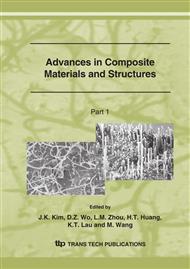p.241
p.245
p.249
p.253
p.257
p.261
p.265
p.269
p.273
Mechanical Behaviours for Textile Composites by FEM Based on Damage Mechanics
Abstract:
To make an expansion of composite consumption ever widening with use at demanding and safety critical applications, it is important to establish the evaluation technique of the strength, the safety, etc. To reach the goal with a useful reliable technique, we have developed a numerical simulation program on damage development of composites based on damage mechanics. The following points are the keys to simulate the mechanical behavior; (1) The generation technique of FE model with yarns and matrix, (2) The classification of anisotropic damage mode based on damage mechanics, (3) Multi-scale modeling by Mesh superposition method. In this paper, the numerical technique and the results of multi-scale analysis of woven composites are described.
Info:
Periodical:
Pages:
257-260
Citation:
Online since:
March 2007
Price:
Сopyright:
© 2007 Trans Tech Publications Ltd. All Rights Reserved
Share:
Citation:


